The Peninsula
Bridges of Understanding: The Peace Corps & The U.S. – Korea Alliance
Published October 3, 2013
Category: South Korea
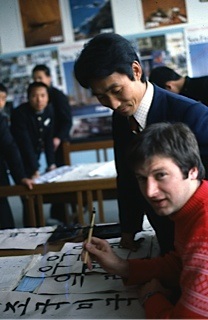
By Gerard Krzic
Anyone visiting Korea and sightseeing at a rural Buddhist temple usually passes over a stone bridge that crosses a stream or river before entering the main temple grounds. It has been said that the bridge represents crossing oceans as one moves from the land of daily hardships to the land of enlightenment and understanding. Like these stone links between two lands, the alliance between the United States and the Republic of Korea has moved each country toward mutual understanding and cooperation across the Pacific Ocean. This bridge of collaboration over the past 60 years has been built upon the interaction between the people of both countries. One organization that has contributed to this strong bond is the United States Peace Corps.
 From 1966 to 1981, nearly 2,000 Peace Corps volunteers and staff members shared their lives with their Korean counterparts in health, education and social service projects. They were witness to the tremendous work ethic of the Korean people as the groundwork was being laid for the Korea we see now in the 21st century.
From 1966 to 1981, nearly 2,000 Peace Corps volunteers and staff members shared their lives with their Korean counterparts in health, education and social service projects. They were witness to the tremendous work ethic of the Korean people as the groundwork was being laid for the Korea we see now in the 21st century.
Rick Laylin was a member of the first group of Peace Corps volunteers, known as “K-1,” who arrived in Korea in 1966 to answer President Kennedy’s call for Americans to give two years of their lives in service to the developing world. Rick recalls Korea of that time: “Korea was still struggling to develop its unique identity in the aftermath of the Korean War and, especially in the countryside, 150 miles south of Seoul, seemed to border on the impoverished.”
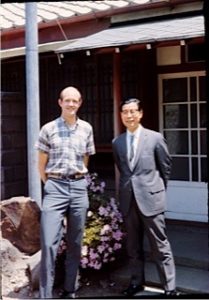 Rick’s first-year assignment was to teach English as a Foreign Language (TEFL) at The Boys High School in Jeonju, a city in the southwest part of the peninsula. In his second year, he was posted to Chonbuk National University to develop a TEFL training program for teachers from around the province. Rick remembers entering that second year assignment: “That second year was a totally different experience from the first year, and not nearly as frustrating as the first year since I now had a year’s worth of experience to draw upon. I made several new friends in the process, but still had the old friends as well, so it was doubly rewarding.”
Rick’s first-year assignment was to teach English as a Foreign Language (TEFL) at The Boys High School in Jeonju, a city in the southwest part of the peninsula. In his second year, he was posted to Chonbuk National University to develop a TEFL training program for teachers from around the province. Rick remembers entering that second year assignment: “That second year was a totally different experience from the first year, and not nearly as frustrating as the first year since I now had a year’s worth of experience to draw upon. I made several new friends in the process, but still had the old friends as well, so it was doubly rewarding.”
In his two years there, Rick developed many friendships, aided by his first co-teacher, mentor and friend, Mr. Kim Jeong Seok. Through Mr. Kim’s patient guidance and his own sensitivity to the Korean culture, manifested in a lot of non-verbal behavior such as bowing, handshaking, and smiling, Rick felt that he adjusted well in spite of the initial difficulty learning Korean. In particular, he felt the Korean people, in spite of the difficult living conditions, were welcoming and accommodating.
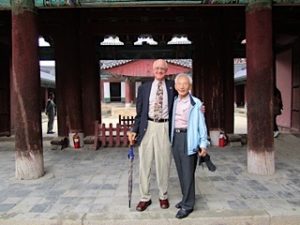 Fast forward to October, 2009: Rick found himself back in Korea 43 years after he had first arrived on the peninsula. This time he was there as a member of one of the Korean Revisits sponsored by the Korea Foundation for former Peace Corps Volunteers. He visited his old schools in Jeonju and met with his old colleagues. When asked to reflect on his time in Korea as a Peace Corps Volunteer, Rick reminisced that the Korean people were extremely hospitable, warm, friendly and above all, forgiving of his youthful ineptitude when it came to teaching. He felt that his greatest contribution was not only the English teaching he provided but also the mutual understanding created through his presence in the town. The Korean people could see that there were Americans who found great satisfaction living and working with them: “I think that the message that they got from me was that I was genuinely happy to be there and working with their students to improve their English speaking skills, which could help them to get ahead in life.”
Fast forward to October, 2009: Rick found himself back in Korea 43 years after he had first arrived on the peninsula. This time he was there as a member of one of the Korean Revisits sponsored by the Korea Foundation for former Peace Corps Volunteers. He visited his old schools in Jeonju and met with his old colleagues. When asked to reflect on his time in Korea as a Peace Corps Volunteer, Rick reminisced that the Korean people were extremely hospitable, warm, friendly and above all, forgiving of his youthful ineptitude when it came to teaching. He felt that his greatest contribution was not only the English teaching he provided but also the mutual understanding created through his presence in the town. The Korean people could see that there were Americans who found great satisfaction living and working with them: “I think that the message that they got from me was that I was genuinely happy to be there and working with their students to improve their English speaking skills, which could help them to get ahead in life.”
Nine years after Rick had completed his Peace Corps service, the 41st group of volunteers arrived in Korea in January of 1977. I was fortunate to be a member of that group. Having left the U.S. for Korea on my 24th birthday, I was about to embark on a journey that would transform my life.
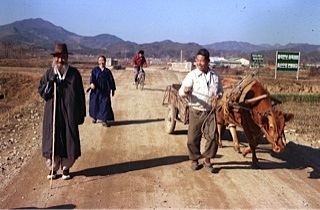 After a three-month training program focusing on Korean language, culture and TEFL pedagogy. I arrived at my site – Yecheon, a rural village in the northern part of Gyeongsang Buk province. Similar to Rick, I also taught English, but my assignment was in Dae Chang Boys Middle School.
After a three-month training program focusing on Korean language, culture and TEFL pedagogy. I arrived at my site – Yecheon, a rural village in the northern part of Gyeongsang Buk province. Similar to Rick, I also taught English, but my assignment was in Dae Chang Boys Middle School.
At first, being immersed in a totally Korean-speaking environment without other native English speakers brought the usual adjustment difficulties and homesickness. Mistakes in communication – using honorific forms inappropriately, failing to distinguish the differences in sound among certain Korean vowel and consonants – made me very aware of the process of learning a foreign language and appreciative of the struggles many of my students were having learning English.
However, over time and in large part due to the graciousness of my Korean colleagues and friends, my language skills improved and my cultural insights sharpened. I learned of the importance of human relations (인간관계), preserving the “kibun” (기분) of others, and reading “nunji” (눈치). As Rick had Mr. Kim for a mentor, I also was fortunate to benefit from my co-teacher, Mr. Kim Hee Kyeong, who guided me through my first year in Korea. My second year was devoted to teacher training as well. I extended my service time for a third year and along with two other volunteers developed a mini-service corps of Korean college-aged students who provided volunteer services in exchange for English lessons. The students thought of it as our own “mini”Peace Corps.
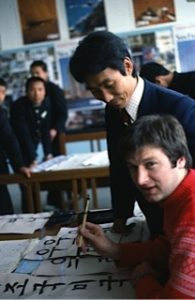 My recollections of Korea were the simple experiences I shared with the people on a daily basis: going on the annual student trip to Gyeongju as a chaperone with over 300 students crammed into slow trains and small rooms in a traditional Korean inn (여관), sitting side-by-side with elementary and middle school students while learning Korean calligraphy, cracking the ice that had formed in the water basins we had to use when washing up outside on frigid winter mornings, sharing taxis to race home before the nightly curfew (동행금지), seeing the joy of our rural students win prizes in the provincial English speech contests over their more advantaged urban peers, witnessing first hand the visible results of the economic development in the form of the early Hyundai car known as the Pony, sharing whispered and animated conversations with my Korean colleagues about domestic and international politics over pots of 막걸리 (makgeolli) or bottles of 소주 (soju).
My recollections of Korea were the simple experiences I shared with the people on a daily basis: going on the annual student trip to Gyeongju as a chaperone with over 300 students crammed into slow trains and small rooms in a traditional Korean inn (여관), sitting side-by-side with elementary and middle school students while learning Korean calligraphy, cracking the ice that had formed in the water basins we had to use when washing up outside on frigid winter mornings, sharing taxis to race home before the nightly curfew (동행금지), seeing the joy of our rural students win prizes in the provincial English speech contests over their more advantaged urban peers, witnessing first hand the visible results of the economic development in the form of the early Hyundai car known as the Pony, sharing whispered and animated conversations with my Korean colleagues about domestic and international politics over pots of 막걸리 (makgeolli) or bottles of 소주 (soju).
In my post Peace Corps life, I have had the privilege to continue my learning of other cultures and interacting with professionals throughout the world in places as diverse as Palestine, Israel, Brazil, South Africa, the former Yugoslavia, and Hungary. Yet, I always look back upon my years in Korea as something special – the place where I learned about the world outside America’s borders.
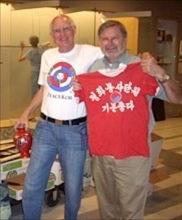 Rick and I are not the only Peace Corps Volunteers who feel our service in Korea was the most transformative experience of our lives. Many returned volunteers have gone on to distinguished careers in government service, education, non-profit agencies, and the private sector, largely in part due to their time in Korea. And, although the Peace Corps presence in Korea ended in 1981, the alliances formed in the 15 years that the program was active has led to the creation of the “Friends of Korea” (FOK).
Rick and I are not the only Peace Corps Volunteers who feel our service in Korea was the most transformative experience of our lives. Many returned volunteers have gone on to distinguished careers in government service, education, non-profit agencies, and the private sector, largely in part due to their time in Korea. And, although the Peace Corps presence in Korea ended in 1981, the alliances formed in the 15 years that the program was active has led to the creation of the “Friends of Korea” (FOK).
Established by returned volunteers, FOK, in conjunction with Korean government agencies, has published “Through Our Eyes,” a book chronicling the Peace Corps experience in Korea, organized a traveling photo exhibit throughout Korea and the U.S., and discussed plans for a collection of the Peace Corps experience in the National Museum of Korean Contemporary History. All these efforts are testaments to the continuing impact that Korea has had on their lives.
For those interested in joining or learning more about Friends of Korea, please visit our web site at http://www.friendsofkorea.net.
Gerard Krzic is a returned Peace Corps Volunteer Korea, 1977-1980 and member of the Friends of Korea Board. The views expressed here are the author’s alone.
All photos were provided by Gerard Krzic and were given permission to be used for this post.
